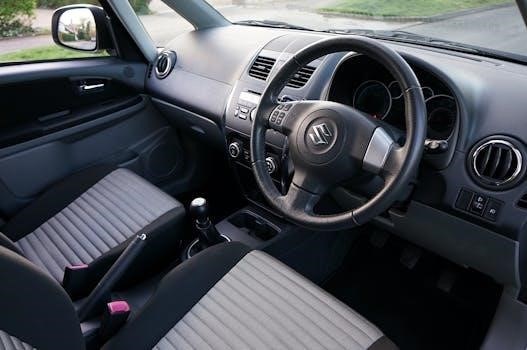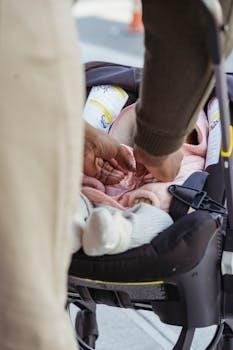Welcome to the Safety 1st family! This guide provides essential information for the proper use of your infant car seat․ Please read all instructions carefully before use․ Failure to follow warnings and instructions can lead to serious injury․ Keep this manual for future reference․

Safety 1st is a well-known brand committed to providing safe and reliable car seats for infants and children․ Their product line includes a variety of options designed to meet different needs and stages of development․ This particular instruction manual focuses on infant car seats, which are specifically designed to protect the most vulnerable passengers, newborns and young babies․ Safety 1st car seats are engineered with safety features and tested to meet or exceed industry standards․ They prioritize ease of use and proper installation, two critical factors in ensuring the safety of your child․ These car seats are built with the understanding that proper usage and installation are paramount for their effectiveness․ Before using the car seat, parents and caregivers must familiarize themselves thoroughly with its design, functions, and specific instructions in this manual․ Safety 1st aims to offer parents peace of mind, ensuring children’s safety during car travel through well-designed products and clear instructions․ Understanding the importance of every detail is vital for a secure journey․
Safety 1st OnBoard 35 LT Overview
The Safety 1st OnBoard 35 LT is an infant car seat meticulously designed for babies weighing between 4 and 35 pounds, and up to 32 inches in height․ This model emphasizes safety and convenience, offering a reliable solution for transporting newborns and young infants․ The car seat is engineered for rear-facing use only, as this is the safest position for infants in a vehicle․ It features a lightweight design that simplifies carrying and transferring the seat․ The OnBoard 35 LT is compatible with specific Safety 1st stroller models, making it a versatile option for parents․ It comes with a base that facilitates secure and swift installation in vehicles․ The car seat is also constructed with materials that are easy to clean and maintain, ensuring a hygienic environment for the child․ The Safety 1st OnBoard 35 LT is committed to providing a safe, comfortable, and practical car seat for your infant, adhering to high safety standards․

Weight and Height Limits for Infant Car Seats
Understanding weight and height limits is crucial for safe car seat use․ The Safety 1st OnBoard 35 LT is specifically designed for infants weighing between 4 and 35 pounds․ Additionally, the maximum height limit is 32 inches․ It is imperative to adhere to these limits to ensure the car seat provides optimal protection․ Using a car seat beyond its specified limits can compromise its effectiveness in a crash․ Regular monitoring of your child’s weight and height is essential․ Once your child exceeds either the weight or height limit, it is time to transition to a different car seat․ Using a seat designed for bigger children․ Transitioning too early or too late can both pose risks to your child’s safety․ This car seat is intended for rear-facing use only, and the weight and height limits are designed to support this position safely․ Always double-check the manufacturer’s guidelines to ensure proper usage․
Importance of Following Manual Instructions
The importance of meticulously following the instruction manual cannot be overstated․ This manual contains crucial, step-by-step directions for the safe installation and use of your infant car seat․ Ignoring these instructions can significantly increase the risk of injury to your child in the event of an accident․ The manual provides specific guidelines on how to secure the car seat correctly, how to adjust straps, and how to use the various features of the seat․ The car seat is designed to offer the highest level of protection possible, but only if used as directed․ Failure to adhere to the manufacturer’s instructions could mean that your child is not properly restrained․ This could result in severe injuries or even death․ Therefore, always read the manual carefully․ Refer to it when installing the seat, and keep it handy for future reference․ It is your primary guide to ensuring your child’s safety on the road․
Proper Installation with a Base
The use of a compatible base is crucial for the proper installation of your infant car seat․ The base provides a secure and stable foundation, making the process of getting the car seat in and out of the vehicle much easier․ When installing the base, always ensure that it is firmly attached to the vehicle seat using either the vehicle’s seat belts or the LATCH system․ The base must be level and not wobble when properly installed․ Refer to the car seat’s instruction manual and your vehicle’s owner’s manual for detailed instructions on how to correctly install the base․ It’s important to check the base’s installation each time before placing the car seat on it․ The base should be firmly connected to the vehicle, and the car seat should click securely into place․ Never use a base that is not designed for your specific car seat model, as this can create a risk to your child’s safety․ Improper installation can reduce the effectiveness of the car seat, and place your child at risk․

Compatibility with Strollers
Many Safety 1st infant car seats are designed to be compatible with a range of strollers, creating a convenient travel system․ This allows for seamless transitions between car and stroller without disturbing your sleeping child․ It is crucial to ensure that your specific car seat model is compatible with the stroller you intend to use․ Always refer to both the car seat and stroller manuals for compatibility information and proper attachment instructions․ Incorrect attachment can be unsafe․ Typically, the car seat will click securely onto the stroller frame․ Always check that the car seat is firmly locked in place before use․ Never force the connection, and if it does not fit easily, double-check the compatibility․ When using the car seat with a stroller, be sure to adhere to weight limits specified for both the car seat and the stroller․ Always use the stroller’s safety features as well, such as brakes․ Using the car seat with a compatible stroller provides a convenient, safe travel solution, but following all instructions is still paramount․
Vehicle Seat Compatibility and Placement
Proper vehicle seat compatibility and placement are crucial for your child’s safety․ Consult both your vehicle owner’s manual and the car seat instruction manual to determine the appropriate seating positions for installing the car seat․ The car seat should only be installed on forward-facing vehicle seats․ Never install a car seat on seats that face the sides or rear of the vehicle․ The center rear seat is often considered the safest position for a car seat, if your vehicle allows, but always check your vehicle’s manual for specific recommendations․ Ensure the car seat sits flat on the vehicle seat, with the car seat base making full contact with the vehicle seat․ Avoid placing the car seat on seats with active air bags, especially when rear-facing․ It’s also important to check that the vehicle seat belt or LATCH system is used correctly and tightly to secure the car seat․ If you’re uncertain about which car seat is compatible with your vehicle, seek advice from a certified car seat technician․
Rear-Facing Installation Guidelines
Rear-facing installation is the safest way for infants and young children to travel in a vehicle․ Ensure the car seat is properly installed with the base according to the manufacturer’s instructions for rear-facing mode․ Always use the correct belt path for rear-facing, as indicated in your car seat manual, whether you are using the vehicle seat belt or the LATCH system․ The car seat’s recline angle should be appropriate for your child’s age and size, usually adjusted to prevent the child’s head from falling forward․ Be sure the car seat is securely installed, and does not move more than one inch side to side or front to back when tested at the belt path․ Verify the harness straps are snug and positioned correctly, at or slightly below the child’s shoulders for rear-facing․ Never place a rear-facing car seat in a seating position with an active frontal airbag․ Always refer to your car seat’s manual for specific guidance on rear-facing installation, as different models may have different requirements․
Airbag Safety and Child Restraints
Airbags are designed to protect adults in a crash, but they can be dangerous for children, especially those in rear-facing car seats․ Never place a rear-facing car seat in the front seat of a vehicle where there is an active frontal airbag․ The force of an inflating airbag can cause serious injury or death to a child․ If your vehicle has a passenger airbag, ensure it’s deactivated before installing a rear-facing car seat in the front․ Always consult your vehicle owner’s manual for guidance on airbag deactivation․ Use the child restraint only on vehicle seats that face forward․ Never use car seats on seats that face the sides or rear of the vehicle․ If possible, use the center seating position as this is often the safest position․ For vehicles without a back seat, refer to the vehicle owner’s manual for specific instructions regarding child restraint placement and airbag safety․ Remember, passenger safety is paramount and you should always prioritize the safest location for your child’s car seat․
Keeping Instruction Manuals for Future Use

It’s crucial to retain your car seat instruction manual for future reference․ This manual contains vital information about the proper use, installation, and maintenance of your Safety 1st infant car seat․ Misplacing it can lead to incorrect usage, potentially compromising your child’s safety․ When transitioning to different stages of car seat usage or if you need to reinstall the seat, the manual is invaluable․ It includes specific instructions on weight and height limits, proper harness adjustments, and cleaning guidelines․ Should you decide to sell or donate the car seat, the manual must accompany it to ensure the new user is also fully informed of all safety precautions․ Keep the manual in a safe and accessible place, such as the vehicle’s glove compartment or a designated file․ Regularly reviewing the manual will keep you up to date on best safety practices, reinforcing your knowledge and ensuring your child’s continued safety․
